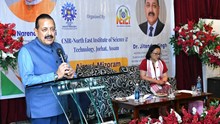
In a scientific milestone that blurs the line between fiction and reality, US-based biotechnology company Colossal Biosciences has successfully brought the dire wolf, a species extinct for over 10,000 years, back to life. The company revealed on Monday, April 7, 2025, that two genetically engineered dire wolf pups, Romulus and Remus, were born on October 1, 2024, marking the first successful case of animal de-extinction.
The pups were created using ancient DNA collected from dire wolf fossils dating back between 11,500 and 72,000 years. Colossal scientists reconstructed the entire genome of the dire wolf and used CRISPR gene-editing technology to bring the species back to life. The howls of Romulus and Remus, now being heard for the first time in millennia, were shared by the company online—sparking global fascination and excitement.
“This is not just a win for Colossal,” the company wrote on X (formerly Twitter), “but a leap forward for science, conservation, and humanity.” The team behind the breakthrough includes Colossal’s co-founders—entrepreneur Ben Lamm and Harvard geneticist Dr. George Church, who have also been working on reviving other extinct species such as the woolly mammoth, dodo, and Tasmanian tiger.
While dire wolves may resemble today’s gray wolves, they are genetically distinct and belonged to a separate lineage. Unlike gray wolves and jackals, there is no evidence of them interbreeding with other canid species. The revival of these predators highlights not only Colossal’s scientific prowess but also its mission to restore lost biodiversity and rebuild damaged ecosystems.
The company says it will closely monitor the growth and well-being of the pups while maintaining transparency and ethical standards. As Romulus and Remus mature, they represent more than a biological curiosity—they stand as living proof that humanity now holds the power to reverse extinction.
With this development, de-extinction has moved from theory to reality, opening new doors for science and environmental recovery across the globe.
















